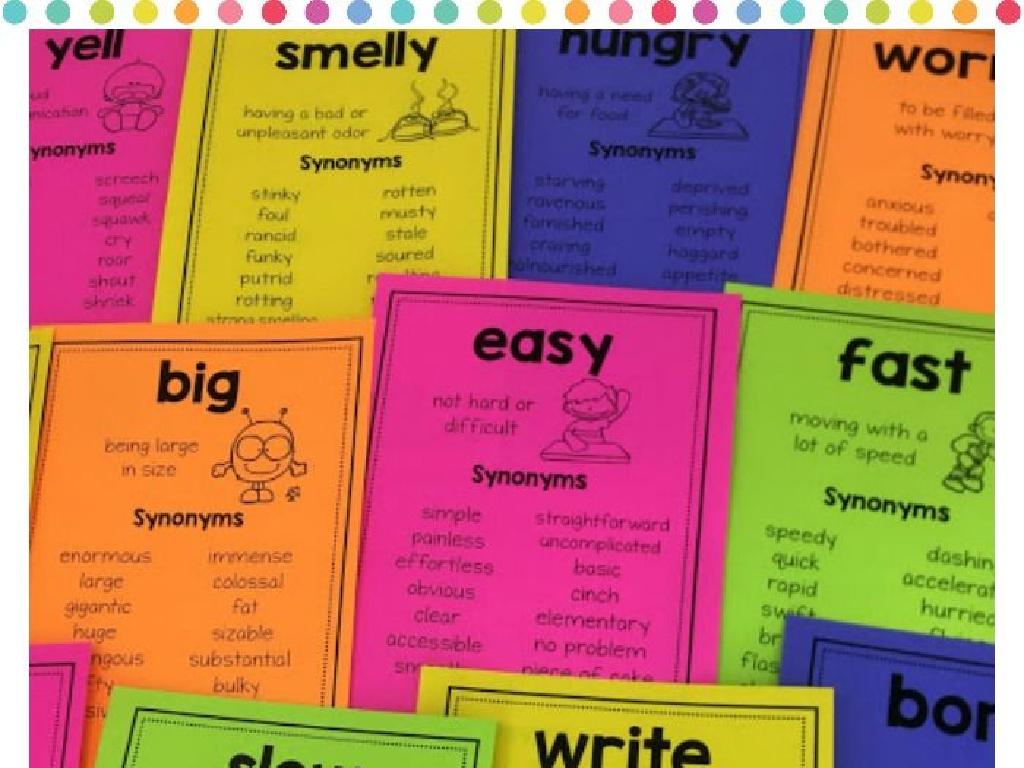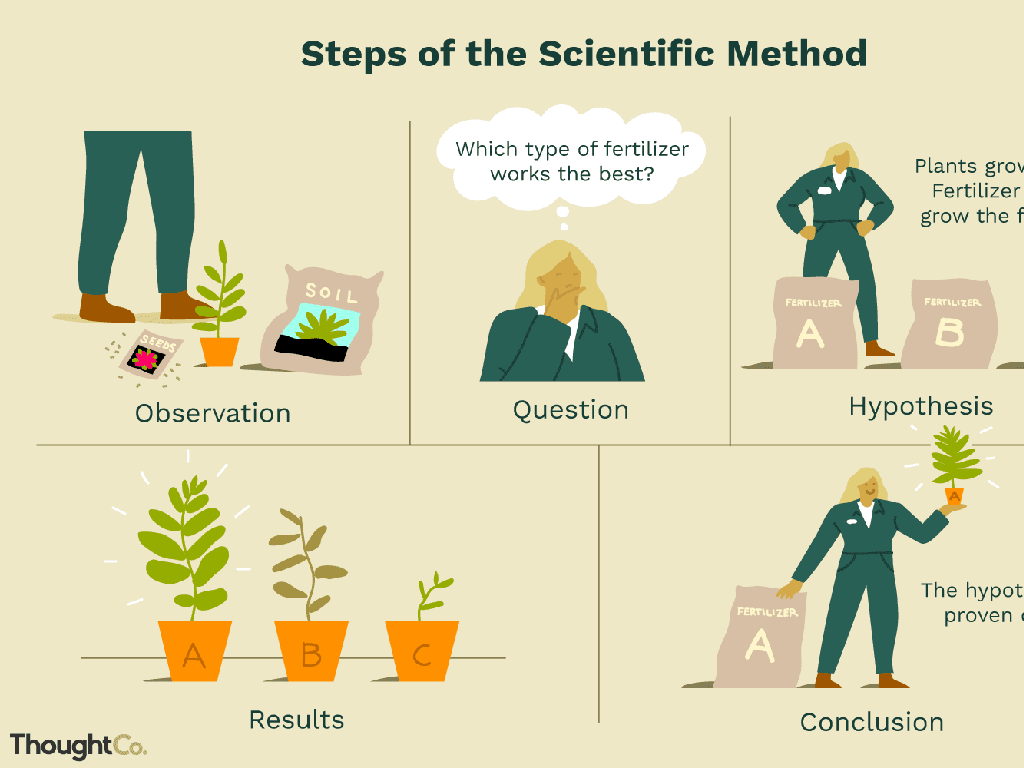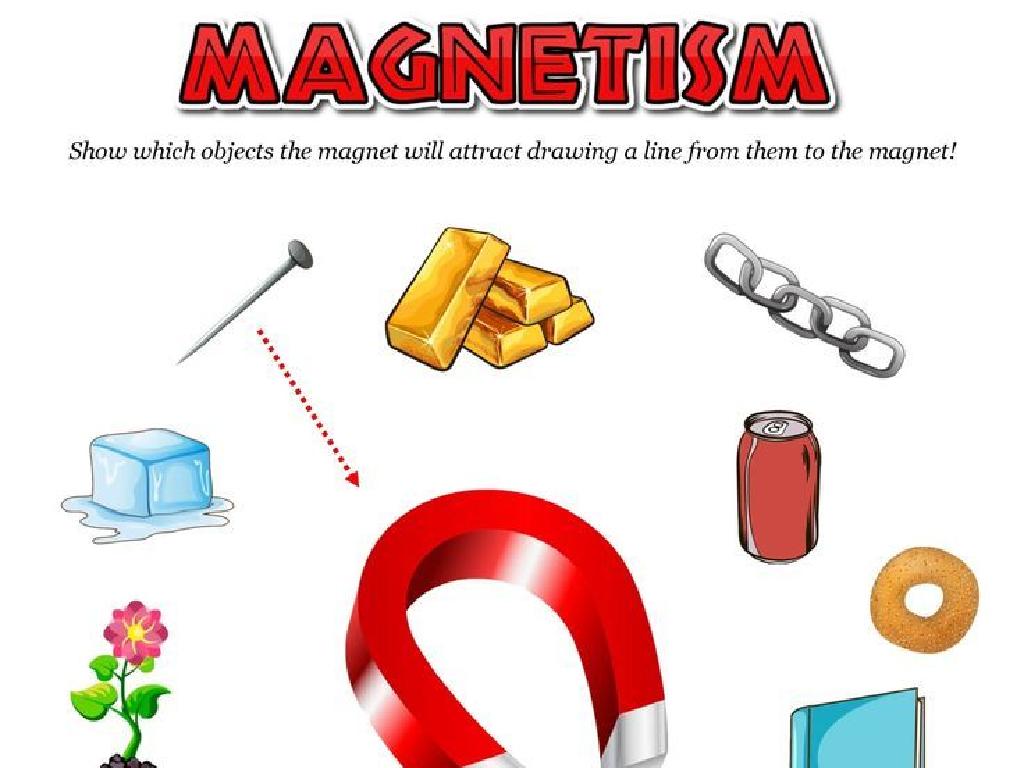Make A Number Using Addition - Sums Up To 5
Subject: Math
Grade: Kindergarten
Topic: Take Apart Numbers Up To 5
Please LOG IN to download the presentation. Access is available to registered users only.
View More Content
Welcome to Addition!
– Greetings, young mathematicians!
– Adding to make numbers
– We’ll use objects to add together
– Numbers can add up to 5
– Like 2 apples + 3 apples = 5 apples
– Let’s practice addition!
– We’ll do fun activities with addition
|
This slide is designed to introduce Kindergarten students to the concept of addition as a method of making numbers. Start by greeting the students warmly to create an inviting learning atmosphere. Explain that addition is simply putting numbers together to make a new number. Use tangible examples like adding apples or blocks to visually demonstrate the concept. Emphasize that any combination of numbers that adds up to 5 is what we’re focusing on. Engage the students with hands-on activities where they can physically combine items to reach the sum of 5, reinforcing the concept through practice. The activities could include using counters, drawing, or interactive games. Encourage participation and celebrate their successful additions to foster a positive attitude towards math.
Learning Addition: Making Numbers Add Up to 5
– What is addition?
– Addition means putting numbers together
– Adding makes a new number
– When we add, we combine numbers like 2 and 3 to make 5
– The ‘+’ sign means add
– We use ‘+’ to show we are adding, like 1+4
– Let’s add numbers up to 5
– Practice with numbers 0 to 5 to make sums of 5
|
This slide introduces the concept of addition to Kindergarten students. Start by explaining that addition is a way of putting numbers together to make a new number. Use simple language and real-life examples, such as combining groups of toys or snacks, to illustrate the concept. Show the addition sign ‘+’ and explain that it tells us to combine numbers. Engage the students with hands-on activities where they can physically combine items to reach the sum of 5, reinforcing the concept that addition brings numbers together to make a bigger number. Encourage them to practice with different combinations of numbers up to 5, such as 2+3, 4+1, and 5+0.
Making Number 2 with Addition
– Starting with number 2
– 1 plus 1 equals 2
– Example: One apple plus one apple makes two apples
– Adding makes numbers
– Practice with different numbers
– Try 0 plus 2 and 2 plus 0 to make 2
|
This slide introduces the concept of creating numbers through addition, specifically the number 2. Start by explaining that addition is putting together numbers to make a new number. Use tangible examples like apples to illustrate the concept. Encourage the children to use their fingers to count and add. After explaining 1 plus 1 equals 2, have the students practice with different combinations that add up to 2, reinforcing the idea that there are multiple ways to make the same number with addition. This activity will help build a foundational understanding of addition for the students.
Making Number 3 with Addition
– Start with number 2
– Add 1 to make 3
– 2 + 1 equals 3, see?
– Try 1 plus 1 plus 1
– 1 + 1 + 1 also equals 3
– We made 3 in different ways!
|
This slide is aimed at helping Kindergarten students understand that the number 3 can be made by adding smaller numbers together. Start by showing them 2 and then adding 1 to make 3. Next, demonstrate that adding three 1s together also makes 3. Use physical objects like blocks or counters to visually represent the addition. Encourage the students to come up with their own ways to make 3 using addition, and praise their creativity. This activity will help them grasp the concept of addition as putting together and the idea that numbers can be composed in different ways.
Making Number 4 with Addition
– Can we make the number 4?
– Yes! 2 plus 2 equals 4
– Two pairs make four
– Try 1 plus 1 plus 1 plus 1
– Counting one by one to four
– Different ways to make 4
– Explore with objects like blocks or fingers
|
This slide is aimed at helping Kindergarten students understand that the number 4 can be made using addition in different ways. Start by asking the class if they can make the number 4 to engage them. Show that adding 2 and 2 makes 4, and also demonstrate that adding 1 four times also makes 4. Use visual aids like blocks or fingers to help them see the concept. Encourage the students to think of other combinations that add up to 4, and allow them to use objects or drawings to represent their ideas. This activity will help solidify their understanding of addition and the concept of number building.
Making Number 5 with Addition
– Let’s learn to make 5
– Example: 2 plus 3 equals 5
– Combining 2 items with 3 items gives us 5 items
– Explore other combinations
– What other numbers add up to 5? Try 1+4 or 0+5
– Practice making 5 together
– Use objects like blocks or fingers to practice
|
This slide is aimed at helping Kindergarten students understand the concept of addition by making the number 5 using different number combinations. Start by demonstrating with a simple example, such as 2+3. Then, encourage the children to find other pairs of numbers that add up to 5, reinforcing the concept that there are multiple ways to reach the same sum. Use tangible objects like blocks, beads, or fingers to make the activity interactive and to help them visualize the concept. During the next class, have a hands-on activity where students can practice making 5 in groups or individually, and share their findings with the class.
Practice Time: Making Number 4
– Try making the number 4
– Find different ways to add up to 4
– Example: 1+3, 2+2, or 0+4
– Use fingers or objects for counting
– Counting physical items can help understand addition
– Work together with friends
|
This slide is an interactive activity for students to practice addition within 5, specifically focusing on making the number 4. Encourage the children to use their fingers or classroom objects like blocks or counters to visualize the addition. They should explore different combinations that add up to 4, such as 1+3 or 2+2. Working in pairs or small groups can foster collaboration and idea sharing. As a teacher, walk around the classroom to assist and encourage students, and consider offering praise for creativity in finding different combinations. This hands-on activity will help solidify their understanding of basic addition and number composition.
Class Activity: Addition Art
– Choose classroom objects
– Make groups for 2, 3, 4, and 5
– Draw and write addition sentences
– Example: 2 pencils + 1 eraser = 3
– Share your art with the class
|
This activity is designed to help Kindergarten students understand addition by using tangible objects to create visual art. Teachers should facilitate the selection of objects and guide students in forming groups that total the numbers 2 through 5. Encourage students to draw their grouped objects and then write the corresponding addition sentence (e.g., 1 block + 1 block = 2). After completing their art, students should be given the opportunity to present their work to the class, explaining their addition sentences. This reinforces the concept of addition and allows for peer learning. Possible variations of the activity could include using stickers, stamps, or cut-out shapes to represent different numbers.
Great Work on Addition!
– You all did amazing today!
– Making numbers by adding
– We used addition to make numbers up to 5
– Adding means putting together
– Like 2+3 makes 5 – we put 2 and 3 together
– Practice makes perfect
– Keep practicing with different numbers!
|
This slide is a conclusion to reinforce the concept of addition for the students. It serves as positive reinforcement for their efforts in learning how to make numbers using addition. Emphasize that addition is simply the process of combining two or more numbers to make a new number. Encourage the students to continue practicing with different numbers at home, using toys or objects to visually represent the addition process. Remind them that with practice, they will become even better at adding numbers together. You can suggest parents to help their children find opportunities to practice addition in everyday life, such as counting apples or adding up the number of steps they take.



/civil_war_history_materials.jpg)


